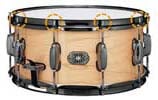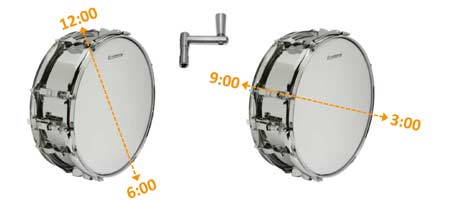Drum Buyer's Guide
Whether you're buying your first drum set or you're building a set that would make Neil Peart jealous, it's important to know which gear you'll need and the AMS Buyer's Guide will help you find it.
Advice for First Time Buyers
As you search for your first drum set consider the following:
1. Price range
Set an appropriate price range. You can easily filter your search results on AMS using the price range selection filters on the left side of the page or sort by 'Low to High' or 'High to Low' to see all products in order of price.
2. Size/age of the player
Drum sets are available in numerous configurations and sizes so it’s important to find one that will be the best physical fit for you so consider your age and size. In order to properly play your drum set you have to be able to handle it comfortably. For young children there are junior size drum sets available that are scaled down for ages 5 to 7 years of age. For age 8 through teens the standard full size drums set are best.
3. Style of music you want to play
The style of music you play will require the right tool for the job. Identify your favorite bands and drummers and research the gear they use -the guy in the jazz trio most likely isn’t using the same gear as the guy in the metal band so choose a drum set that best fits the music. Four piece kits are great for jazz and rock and for gigging players while 5 piece kits can work for almost every situation in between. Go big with 6 and 7 piece sets which offer more possibilities for all drummers.
Images courtesy of: Drum Workshop Kitbuilder
Wood & Construction
Wood and Tone
The woods used to make the drums play an important role in shaping the sound, look and feel of the drum.
Maple
Balanced high and mid range
Enhanced low end
Excellent for live performance
Birch
Enhanced highs and lows
Reduced midrange
Excellent for recording
Mahogany
Balanced high and midrange
Extremely rich low end
Warm and vintage sound
Oak
High end attack
Resonant lows
Great volume
Acrylic, steel and carbon fiber
Have become popular options with the pros
Images courtesy of: Drum Workshop Snare Drums
Other Woods
Beech
Clear, powerful and rich tone
Ash
Clear attack
Balanced low end
Basswood, Falcata, Poplar and Lauan
Are low cost alternatives
Construction and Tone
Drum shells
are made from multiple plies of one type or several types of wood. The more plies a shell has will increase the attack and volume of the drum but will decrease resonance. The fewer plies a shell has will decrease the drum’s volume but increase its resonance. The most common shell sizes are 8, 10, 12, 13, 14 or 16 inches in diameter. Depths range from shallow to deep.
The bearing edge
of a drum also plays a role in shaping the drum’s sound. Edges can be cut at either a 45 or 30 degree angle. A sharp bearing edge cut at 45 degrees will result in a brighter sounding sound with more cut and sensitivity. When cut at 30 degrees, the edge will be more round, making the drum sound mellow and thick.
Drum shell hardware
starts with the castings that come in many shapes and sizes, hollow or solid. Powder coating offers many color options but the standard is plating chrome, nickel, black nickel or gold. The counter hoops come in flanged, die-cast or wood and can follows the same as above. Isolation mounts enhance sustain and are low mass to show more of the shell. This is usually on middle to higher-priced drums.
Images courtesy of: Drum Workshop - DWDrums.com
Finishes & Lacquering
Finishes
Drum finishes come in several varieties but the most commonly used are wraps. Wraps are made of vinyl which is a flexible durable covering that comes in solid colors, patterns and sparkles.
Lacquering
Lacquering is a multi-step process used to create solid colors, sparkles, crushed glass, fades or bursts. The wood grain is usually visible beneath fades and bursts which can have a high gloss, satin, waxed or hand-rubbed oil finished look.
Images courtesy of: Drum Workshop Kitbuilder
Hardware & Cymbals
Hardware
Hardware refers to the metal components of the drum set including the bass drum pedal; stands, mounts and clutches which support the drums and cymbals; drum thrones; racks and accessories.
In most cases drum sets will not include a drum throne. Hardware can be single or double braced, light weight to heavy duty. Drum Hardware Packages come with cymbal stands, hi-hat stands, snare stands and bass drum pedals.
Cymbals
Most drum sets do not come with cymbals
so you'll have to identify the cymbals that fit the style of music you play. The most commonly used cymbals are the ride, hi-hat, crash, splash and China cymbal. There are many shapes, sizes and weights to choose from, and each creates a unique sound.
Sheet cymbals
are made from rolled sheets which are cut into discs, shaped and then hammered or lathed. They tend to be consistent in their sound and are available in pre-packed boxed sets or individually. Sheet cymbals are the most affordable option and they are great for beginners or students.
Cast cymbals
are made by smelting base metals into castings which are then heated, rolled, shaped, hammered and lathed. This process offers a wide range of sounds and colors.
Browse Cymbals
Crash Ride Cymbals
Cymbal Packs
Special Effects Cymbals
Cymbal Cases & Bags
Cymbal Accessories
Drumheads & Tuning
Tuning a drum
is the art of getting the desired sound balanced with the right amount of ring. Single ply heads have a higher tuning range and increased projection while two ply heads have a lower range. Each style of music has its own characteristics so experiment with several sounds to find one that fits your style of playing.
The first step in tuning a drum
is to make sure that the drumhead is tensioned evenly. Isolate the head that you are tuning by placing the drum on the floor or on a table away from the rest of the drum set. Inspect the bearing edge and make sure that it is clean. Next, check the mounting screws on the drum hardware and tighten them up if they have become loose. Place the head on the center of the drum; make sure the counter hoop is clean then place it on top of the head.
Browse Drum Heads
1. With your fingers tighten the tuning screws (key rods). 2. With the drum key (below, center) tighten each screw one rotation at a time, using a crossing pattern –first the screws at 12:00 and 6:00, then the screws at 3:00 and 9:00.
2. With the drum key (below, center) tighten each screw one rotation at a time, using a crossing pattern –first the screws at 12:00 and 6:00, then the screws at 3:00 and 9:00. 3. As the tension on the head increases the wrinkles will smooth out. Tap the head near a tuning lug and listen to the pitch. After you have made your way around the drum press on the center of the head to stretch and seat it.
3. As the tension on the head increases the wrinkles will smooth out. Tap the head near a tuning lug and listen to the pitch. After you have made your way around the drum press on the center of the head to stretch and seat it.
4. Fine-tune the drum by listening to each tension point near the tuning lugs. Even the pitch for any lug that sounds too high or too low.
5. When the head is in tune, turn the drum over and repeat the process on the opposite head.
Drumsticks & Brushes
Drumsticks
come in many sizes, lengths and dowel (handle) diameters. The most common sizes are (from widest to thinnest) 2B, 5B, 5A and 7A. Choose a stick that is comfortable for your hand and durable for your playing style.
The tip
of a drumstick is made of wood or nylon; wood has a natural softer sound on cymbals while nylon has more stick definition. The shape of the tip can be round, oval, acorn, or barrel-shaped.
Brushes and specialty sticks (such as rods) can be used instead of traditional drum sticks for playing styles that require softer textures.
Brushes
require great technique. Brushes are telescoped or fixed with metal or plastic bristles which can be bent, looped or have ball ends.
Rods
are commonly used in low-volume settings. Rods are made of a group of small dowels (wood or plastic) that have been banded together.
Browse Drum Brushes & Rods